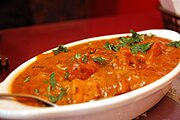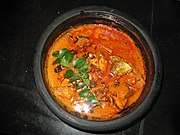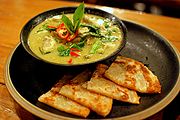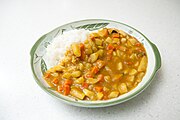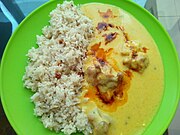Curry/ja: Difference between revisions
Created page with "<br/>" Tags: Mobile edit Mobile web edit |
No edit summary Tags: Mobile edit Mobile web edit |
||
| (37 intermediate revisions by the same user not shown) | |||
| Line 4: | Line 4: | ||
| image = Indiandishes.jpg | | image = Indiandishes.jpg | ||
| caption = インドカレー | | caption = インドカレー | ||
| place_of_origin = [[Indian subcontinent]] | | place_of_origin = [[Wikipedia:Indian subcontinent|Indian subcontinent]] | ||
| region = Worldwide | | region = Worldwide | ||
| main_ingredient = 肉あるいは、野菜, オイルあるいは、[[ghee/ja]], [[spices/ja]] | | main_ingredient = 肉あるいは、野菜, オイルあるいは、[[ghee/ja]], [[spices/ja|スパイス]] | ||
}} | }} | ||
'''カレー'''('''Curry''')は、主に[[South Asian cuisine/ja|南アジア料理]]に関連する、スパイスで味付けされたソースまたは[[gravy/ja|肉汁]]を使った料理である。カレーは[[curry tree/ja|カレーの木]]の葉とは混同されないが、カレーの葉を含むカレーもある。カレーは多くの[[:en:Southeast Asia|東南アジア]]および[[:en:East Asia|東アジア]]諸国の郷土料理で調理される。 | '''カレー'''('''Curry''')は、主に[[South Asian cuisine/ja|南アジア料理]]に関連する、スパイスで味付けされたソースまたは[[gravy/ja|肉汁]]を使った料理である。カレーは[[curry tree/ja|カレーの木]]の葉とは混同されないが、カレーの葉を含むカレーもある。カレーは多くの[[:en:Southeast Asia|東南アジア]]および[[:en:East Asia|東アジア]]諸国の郷土料理で調理される。 | ||
カレーには多くの種類がある。伝統的な料理のスパイスの選択は、その地域の文化的伝統や個人の嗜好に左右される。そのような料理には、材料、スパイス、調理法を示す名前がついている。インド亜大陸以外では、カレーは東南アジアの料理で、[[coconut milk/ja|ココナッツミルク]]やスパイスペーストを使い、ご飯にかけて食べるのが一般的である。カレーは魚、肉、鶏肉、貝類を単独で、または野菜と組み合わせて使う。ベジタリアンのものもある。[[Spice_mix#Masala|マサラ]]ミックスとは、いくつかのカレーによく使われる自家製の乾燥スパイスや乾煎りスパイスの組み合わせのことである。 | |||
ドライカレーは少量の液体を使用して調理され、蒸発させることで他の材料はスパイスミックスでコーティングされた状態になる。ウェットカレーは、[[broth/ja|ブロス]]、[[coconut cream/ja|ココナッツクリーム]]または[[coconut milk/ja|ココナッツミルク]]、乳製品の[[cream/ja|クリーム]]または[[yogurt/ja|ヨーグルト]]、または[[legume/ja|豆]]のピューレ、[[Sautéing/ja|ソテー]]した砕いたタマネギ、または[[tomato purée/ja|トマトピューレー]]をベースにしたソースまたはグレービーソースをかなりの量含む。西洋で市販されている[[Curry powder/ja|カレー粉]]は、18世紀にインドの商人が[[garam masala/ja|ガラムマサラ]]に似たスパイスを[[concoction/ja|調合]]したものをイギリスに帰国したイギリス東インド会社に売ったのがイギリスへの最初の輸出である。 | |||
==語源== | |||
{{Anchor|Etymology}} | |||
[[File:To make a Currey the India Way - Hannah Glasse 1748.jpg|thumb|upright=1.5|[[Hannah Glasse]] | [[File:To make a Currey the India Way - Hannah Glasse 1748.jpg|thumb|upright=1.5|[[:en:Hannah Glasse|Hannah Glasse]]のカレーのレシピ。このレシピはkaṟの英語化された最初の形として知られている。(レシピでは[[:en:Long s|長いs、"ſ"]]が使われている)。]] | ||
カレーは、[[curry tree/ja|カレーノキ]](''Murraya koenigii'')の葉を使った「ソース」や「ご飯のおかず」を意味する[[:en:Tamil language|タミル語]]の''{{IAST|ka↪L_1E5F↩i}}''({{lang|ta|க}})の[[:en:Anglicisation|英語化]]形である。また、''kari''は他の[[:en:Dravidian languages|ドラヴィダ語]]、すなわち[[:en:Malayalam|マラヤーラム語]]、[[:en:Kannada|カンナダ語]]、[[:en:Kodava language|コダヴァ]]でも「あらゆる種類の野菜(または肉)(生または茹でたもの)、カレー」の意味で使われる。''Kaṟ''は、17世紀半ばにインド南東部の[[:en:Coromandel Coast|コロマンデル海岸]]沿いのタミル商人と交易していたイギリス[[東インド会社]]のメンバーによる[[Portuguese cuisine/ja|ポルトガル語]]の料理本に記載されており、「......カリ・ポディまたはカレー粉と呼ばれるスパイスのブレンド」として知られるようになった。英語化された形(スペルは''currey'')で最初に登場したのは[[Wikipedia:Hannah Glasse|Hannah Glasse]]の1747年の著書''[[Wikipedia:The Art of Cookery Made Plain and Easy|The Art of Cookery Made Plain and Easy]]''である。 | |||
1390年代のイギリスの料理本''[[Wikipedia:The Forme of Cury|The Forme of Cury]]''に登場する'''curry'''という単語は無関係であり、「調理する」という意味の中世フランス語''[[wikt:cuire|cuire]]''に由来する。 | |||
==歴史{{Anchor|History}}== | |||
==History== | 東南アジアのオーストロネシア人の商人が南アジア(主にインドとスリランカの南東海岸の港)と東アジアを結ぶ海上交易路で香辛料を取引していた証拠が、紀元前5000年前にまでさかのぼる昔に発見されている。また、[[:en:Mohenjo-daro|モヘンジョ・ダロ]]から出土した紀元前2600年頃の考古学的証拠からは、[[mustard seed/ja|マスタード]]、[[fennel/ja|フェンネル]]、[[cumin/ja|クミン]]、[[tamarind/ja|タマリンド]]の鞘を含む香辛料を搗くために[[mortar and pestle/ja|乳鉢と乳棒]]が使用されていたことが示唆されており、これで料理に香りを付けていた。[[Black pepper/ja|黒胡椒]]は[[:en:Indian subcontinent|インド亜大陸]]と東南アジア原産で、少なくとも紀元前2000年頃から[[Indian cuisine/ja|インド料理]]で知られている。 | ||
スパイシーなシチューの基本的な材料は、[[ginger/ja|ショウガ]]、[[garlic/ja|ニンニク]]、[[turmeric/ja|ターメリック]]の3つだった。考古学者たちは「デンプン粒分析」と呼ばれる方法を用いて、インドで発掘された骸骨と陶器の破片の両方からこれらの香辛料の残留物を特定し、ターメリックとショウガが存在することを発見した。 | |||
16世紀初頭に[[:en:Mughal Empire|ムガル帝国]]が成立したことも、特に北部のカレーに影響を与えた。もうひとつの影響は、1510年に[[:en:Goa|ゴア]]にポルトガルの貿易センターが設立されたことで、[[:en:Columbian Exchange|コロンブス交易]]の副産物としてアメリカ大陸からインドに[[chili pepper/ja|唐辛子]]、トマト、ジャガイモがもたらされた。 | |||
イギリスではソースを使った料理はすべて「カレー」という総称で括られていた。17世紀に[[Anglo-Indian cuisine/ja|アングロ・インド料理]]から[[English cuisine/ja|イギリス料理]]に伝わり、平凡な茹で肉や煮肉にスパイシーなソースが加えられるようになった。カレーは1809年からイギリスのコーヒーハウスで提供されるようになり、1940年代と1970年代に大流行した。19世紀には、カレーはイギリスの[[:en:sugar industry|砂糖産業]]で働くインド人[[:en:indenture|年季奉公]]労働者によってカリブ海に運ばれた。20世紀半ば以降、多くの国のスタイルのカレーがその起源から遠く離れた場所で人気を博し、ますます国際的な[[fusion cuisine/ja|フュージョン料理]]の一部となっている。 | |||
==地域毎{{Anchor|By region}}== | |||
==By region== | ===南アジア=== | ||
=== | {{Main/ja|South Asian cuisine/ja}} | ||
{{Main|South Asian cuisine}} | [[File:Rajma Chawal, from India.jpg|thumb|upright|left|''[[Rajma/ja|ラージマ]]-[[chawal/ja|チャワール]]''・赤インゲン豆のカレー・蒸し米添え・インド産]] | ||
[[File:Rajma Chawal, from India.jpg|thumb|upright|left|''[[Rajma]]-[[chawal]]'' | [[File:Handi-and-karahi.jpg|thumb|right|300px|[[Pakistani cuisine/ja|パキスタン料理]]に使われる伝統的な''[[karahi/ja|カラヒ]]''(左)と''[[handi/ja|ハンディ]]''(右)]] | ||
[[File:Handi-and-karahi.jpg|thumb|right|300px| | インドはカレーの本場であり、多くの[[Indian cuisine/ja|インド料理]]はカレーベースで、さまざまな種類の野菜、レンズ豆、肉を加えて調理する。カレーの内容や調理法は地域によって異なる。ほとんどのカレーは水ベースで、乳製品やココナッツミルクを使うこともある。カレー料理は通常濃厚でスパイシーであり、蒸した米や様々なインドパンと一緒に食べる。例えば、[[Kashmiri cuisine/ja|カシミール料理]]で人気のある[[rogan josh/ja|ローガン・ジョシュ]]は、カシミール産の唐辛子と[[Celosia/ja|ケイトウ]]の赤い花のエキス(''mawal'')で色付けされた赤いグレービーソースを使った羊肉のウェットカレーである。''ゴシュタバ(Goshtaba)''(ヨーグルトのグレイビーソースで煮込んだ大きな羊肉のミートボール)は、西洋のレストランで時折見られる[[Wazwan/ja|ワズワン]]伝統のもう一つのカレー料理である。 | ||
[[Bengali cuisine/ja|ベンガル料理]]では、カレーは''トルカリ''と呼ばれる。カレーには魚介類、野菜、肉類が含まれる。[[Mustard seed/ja|マスタードシード]]と[[mustard oil/ja|マスタードオイル]]は多くのレシピに加えられ、多くの場合[[Tempering (spices)/ja|タルカ]]の形で加えられる。[[:en:Bengal|ベンガル]]で人気のあるカレーには、Murgi'r Lal Jhol、[[Shorshe ilish/ja|Shorshe Illish]]、[[Mutton curry/ja|Kosha Mangsho]]、[[Chingri malai curry/ja|Chingri Malai]]、[[Rezala/ja|Rezala]]などがある。[[Mezban/ja|メズバン]]は、[[:en:Bangladesh|バングラデシュ]]の[[:en:Bengali Muslims|ベンガル系イスラム教徒]]が[[:en:Chittagong District|チッタゴン地区]]で開催する人気の社会的な祭り。 | |||
この祭りには、「メズバニ牛肉」を意味する「メズバニ・ゴシュト」と呼ばれる独特のビーフカレーが登場する。このカレーの調理は、巨大な「[[Dum pukht/ja|deghs]]」と薪、そして長年の経験と完璧な技術を必要とする、大規模かつ複雑な工程である。 | |||
米とカレーはスリランカの主食である。 | |||
===東アジア=== | |||
カレーはアジアの他の地域にも広がった。[[Chinese cuisine/ja|中国料理]]には欠かせないものではないが、中国の南部ではいくつかの料理にカレー粉が加えられている。中国の食料品店で売られているカレー粉はマドラスカレー粉に似ているが、[[Illicium verum/ja|スターアニス]]とシナモンが加えられている。ポルトガルの植民地であったマカオには[[Macanese cuisine/ja|独自の料理伝統]]があり、[[Galinha à portuguesa/ja|ガリーニャ・ア・ポルトゥゲーザ]]やカレーカニなどのカレー料理がある。[[Portuguese sauce/ja|ポルトガルソース]]はカレー風味のソースで、[[coconut milk/ja|ココナッツミルク]]でとろみをつけたものである。 | |||
[[File:Beef curry rice 003.jpg|thumb|upright=.8|left|[[Japanese curry/ja|日本]]スタイル{{lang|ja-Latn|Karē-Raisu}} (カレーライス)]] | |||
[[File:Beef curry rice 003.jpg|thumb|upright=.8|left|[[Japanese curry| | |||
[[Japanese curry/ja|日本のカレー]]は通常、カレーライス({{lang|ja-Latn|karē raisu}}) として食べられている。- カレー、ライス、そしてしばしば漬け物が同じ皿に盛られ、スプーンですくって食べる、よくあるランチタイムの食堂料理である。インドや東南アジアのカレーに比べると辛さや味付けは控えめで、カレーというよりは濃厚な煮込み料理である。イギリス人が[[:en:British Raj|インド植民地]]からカレーをイギリスに持ち帰り、日本には鎖国政策が終わった[[:en:Meiji period|明治時代]](1868年~1912年)に伝わり、日本のカレーは[[Yōshoku/ja|西洋料理]]に分類されるようになった。カレーが全国に広まったのは、[[:en:Imperial Japanese Army|日本陸軍]]や[[:en:Imperial Japanese Navy|海軍]]が、便利な野戦料理や海軍の水筒料理として大々的に採用し、僻地の徴兵にも体験させたことによる。[[:en:Japan Maritime Self-Defense Force|海上自衛隊]]では、毎週金曜日の昼食にカレーを食べるのが伝統となっており、多くの艦艇が独自のレシピを持っている。標準的な日本のカレーは、玉ねぎ、にんじん、じゃがいも、時には[[celery/ja|セロリ]]、そして大きな鍋で煮込んだ肉が入っている。甘みを増すためにすりおろしたリンゴや[[honey/ja|蜂蜜]]が加えられることもあり、代わりに他の野菜が使われることもある。 | |||
[[Japanese curry]] | |||
カレーが[[Korean cuisine/ja|韓国料理]]に広まったのは、1969年に[[Ottogi/ja|オットギ]]がカレー粉で韓国食品業界に参入してからである。韓国のカレーは通常ライスと一緒に提供され、ターメリックの黄金色が特徴である。カレー[[:en:tteokbokki|トッポッキ]]は[[:en:tteok|トック]](餅)、[[:en:eomuk|オムク]](魚の餅)、卵、野菜、カレーで作られる。カレーは[[:en:bokkeumbap|ポックムパプ]](チャーハン)、[[:en:sundubu|スンドゥブチゲ]](絹ごし豆腐のチゲ)、フライドチキン、野菜炒め、サラダなどの韓国料理に加えることができる。 | |||
===東南アジア=== | |||
[[File:Gulai kambing masakan Padang.JPG|thumb|マトン[[Gulai/ja|グライ]](インドネシアのカレー)、通常は[[Nasi padang/ja|ナシ・パダン]]メニューの一部として供される]] | |||
[[File:Gulai kambing masakan Padang.JPG|thumb| | |||
[[Indian Indonesian cuisine/ja|インド・インドネシア料理]]は、[[:en:India|インド]]の本格的な料理をアレンジしたものと、[[:en:Indonesia|インドネシア]]の多様な食文化にインスパイアされた創作料理からなる。[[:en:Indonesian language|インドネシア語]]のカレーは''kari''であり、[[:en:Javanese language|ジャワ語]]のカレーは''kare''である。[[Indonesian cuisine/ja|インドネシア料理]]、特に[[:en:Bandung|バンドン]]では、[[lontong/ja|ロントン]]と牛肉の黄色いカレースープを合わせた'''[[nasi kari/ja|ロントン・カリ]]'''という料理がある。[[Javanese cuisine/ja|ジャワ料理]]では、[[:en:East Java|東ジャワ]]の[[:en:Tuban Regency|トゥバン県]]で[[Portunus pelagicus/ja|ワタリガニ]]のカレーである'''kare rajungan'''が珍味となっている。[[Rendang/ja|ルンダン]]は[[Padang cuisine/ja||ミナン]]を起源とするインドネシアの国民食であり、従来のマレーシアのカレーよりも辛口で肉が多く、ココナッツミルクが多く含まれている。 | |||
[[Indian Indonesian cuisine]] | |||
[[Malaysian cuisine/ja|マレーシア料理]]は、当初はインド系住民を介してカレーを取り入れたのかもしれないが、マレー系住民や中華系住民の間では主食となっている。マレーシアのカレーには通常、ターメリックが豊富なカレー粉、ココナッツミルク、エシャロット、ショウガ、[[belacan/ja|ベラカン]](エビのペースト)、唐辛子、ニンニクが使われる。[[tamarind/ja|タマリンド]]もよく使われる。 | |||
[[Malaysian cuisine]] | |||
[[File:Myanma cuisine.jpg|thumb|数種類の[[Burmese curry/ja|ビルマカレー]]を使った伝統的な料理]] | |||
[[File:Myanma cuisine.jpg|thumb| | |||
[[Burmese cuisine/ja|ビルマ料理]]では、カレーは広く''ヒン''と呼ばれる。一般的に[[Burmese curry/ja|ビルマカレー]]は、エシャロット、タマネギ、ショウガ、ニンニクなどの香辛料とターメリック、パプリカ、ガラムマサラなどの乾燥スパイスをベースにしたカレーで、タンパク質を煮込んだものである。ビルマのカレーは、他の東南アジアのカレーとは異なり、料理の味付けに乾燥スパイスもよく使われ、ココナッツミルクは一部の料理にのみ控えめに使われる。 | |||
[[File:Philippine Chicken curry.jpg|thumb|[[Filipino chicken curry/ja|フィリピンチキンカレー]]は、原地{{lang|fil|[[ginataang manok]]}}の変種で、[[curry powder/ja|カレー粉]]を使う。]] | |||
[[File:Philippine Chicken curry.jpg|thumb|[[Filipino chicken curry]] | |||
[[Philippine cuisine/ja|フィリピンでは]]、2種類のカレーの伝統が、ヒスパニック化した北部とインド化/イスラム化した南部の文化的分裂に対応して見られる。北部では、直線的な新しいカレーレシピが見られる。最も一般的なのは、{{lang|fil|[[ginataang manok]]}}(ココナッツミルクで煮込んだ鶏肉)料理に[[curry powder/ja|カレー粉]]を加えたもので、「[[Filipino chicken curry/ja|フィリピンチキンカレー]]」として知られている。これはフィリピン北部の人々がよく知る普通のカレー料理である。同様に、「カレー」とみなされる他のフィリピン北部料理は、{{lang|fil|[[ginataan]]}}(ココナッツミルクで調理したもの){{lang|fil|[[adobo]]}}、{{lang|fil|[[kaldereta]]}}、{{lang|fil|[[mechado]]}}など、他の土着の肉料理や魚介料理にカレー粉やインド以外のスパイスを加えただけのものであることが多い。 | |||
[[Philippine cuisine| | |||
[[File:Phanaeng mu.jpg|thumb|タイの[[Phanaeng/ja|パナエン]]豚肉入り]] | |||
[[File:Phanaeng mu.jpg|thumb| | |||
[[Thai curry/ja|タイ料理]]では、カレーは{{lang|th|kaeng}}と呼ばれ、通常、唐辛子、タマネギまたはエシャロット、ニンニク、[[shrimp paste/ja|エビペースト]]から作られたペーストをベースにしたソースに肉、魚、または野菜を入れたものである。追加のスパイスやハーブがカレーの種類を決める。唐辛子、[[kaffir lime/ja|カフィアライム]]の葉、[[lemongrass/ja|レモングラス]]、[[galangal/ja|ガランガル]]などの地元の食材が使われ、中部と南部のタイ料理ではココナッツミルクが使われる。北部と北東部のタイカレーには一般的にココナッツミルクは使われない。砂糖とココナッツミルクを使うため、タイカレーはインドカレーよりも甘くなる傾向がある。西洋では、タイのカレーを色で表現することがある。[[red curry/ja|レッドカレー]]は赤唐辛子を使い、[[green curry/ja|グリーンカレー]]は青唐辛子を使う。[[Yellow curry/ja|イエローカレー]]-{{lang|th|kaeng kari}}と呼ばれる。[[:en:Thai language|タイ語]]では{{lang|th|kaeng kari}}と呼ばれ、直訳すると「カレースープ」だが、ターメリックやクミンなどの乾燥スパイスを使い、インドカレーに近い。タイ料理の炒め物には、インド風のカレー粉(タイ語: {{lang|th|phong kari}})を使うものもいくつかある。 | |||
[[File:Cà Ri Gà Vietnamese Chicken Curry 2019-1600.jpg|thumb|鶏肉のCà ri]] | |||
[[File:Cà Ri Gà Vietnamese Chicken Curry 2019-1600.jpg|thumb| | |||
[[Vietnamese cuisine/ja|ベトナム料理]]では''cà ri''と呼ばれ、ココナッツミルク、ジャガイモ、サツマイモ、タロイモ、鶏肉などの材料にコリアンダーやネギを加えて作る。インドカレーというよりスープに近い。ヤギ肉のカレーもあるが、ベトナムでは一部の特別なレストランでしか食べられない。カレーにはパンや春雨、米が添えられることが多い。カレーは南部の料理と考えられている。カレーの他の材料は非常に多様で、肉の材料、カレーを調理するための主な果物、シェフの創造力によって異なります。ベトナムのカレーは、ココナッツミルク、レッドカシュー、玉ねぎ、生姜、ジャガイモ、サツマイモ、ニンジン、大根、野菜、様々な種類の肉でも作られる。 | |||
===アフリカ=== | |||
=== | [[File:Durban's Famous Mutton Bunny Chow.jpg|thumb|upright=0.8|left|南アフリカのダーバンで出された[[Bunny chow/ja|バニー・チャウ]]の一例]] | ||
[[File:Durban's Famous Mutton Bunny Chow.jpg|thumb|upright=0.8|left| | カレーの消費は、植民地時代にインド亜大陸からこの地域への人々の移住とともに[[:en:South Africa|南アフリカ]]に広まった。[[African cuisine/ja|アフリカン]]カレー、[[Cape Malay/ja|ケープマレー]]カレー、[[KwaZulu-Natal/ja|ナタール]]カレーには、伝統的なナタールカレー、ダーバンカレー、[[Bunny chow/ja|バニーチャウ]]、ロティロールなどがある。南アフリカのカレーは[[:en:KwaZulu-Natal|クワズールー・ナタール州]]と[[:en:Western Cape|西ケープ州]]の両方で誕生したようであるが、他のカレーは20世紀後半から21世紀初頭にかけて全国的に発展し、エカシ・カレー、カラー・カレー、[[Afrikaner/ja|アフリカーナー]]・カレーなどがある。[[:en:Durban|ダーバン]]はインド以外のインド人の人口が世界最大である。バニー・チャウまたは「セット」と呼ばれる南アフリカの定番料理は、ラム、チキン、豆のいずれかのカレーをトンネル状にくりぬいたパンに注いで、パンの切れ端を指につけて食べるものである。 | ||
===ヨーロッパ=== | |||
[[File:Chicken Tikka Masala-01.jpg|thumb|[[Chicken tikka masala/ja|チキンティッカマサラ]]]] | |||
[[File:Chicken Tikka Masala-01.jpg|thumb|[[Chicken tikka masala]]]] | |||
カレーは[[Curry in the United Kingdom/ja|イギリス]]で非常に人気があり、ほぼすべての町にカレーハウスがある。イギリスでのカレーの人気は高く、「国民食」とも呼ばれている。2016年には12,000軒のカレーハウスがあり、10万人を雇用し、年間総売上高は約42億ポンドと推定されている。 | |||
提供される料理はイギリス人好みに調理されたインド料理だが、本格的なインド・スタイルへの需要が高まっている。2015年現在、カレーハウスは英国のレストラン事業の5分の1を占めているが、歴史的に低賃金部門であるため、労働力不足に悩まされていた。南アジアからの定着したインド系移民は他の職業に移っており、ヨーロッパ人にカレーを調理させるのは困難で、熟練した移民には高い賃金を支払う必要がある移民規制が、新しいコックの供給を圧迫していた。 | |||
==カレー粉{{Anchor|Curry powder}}== | |||
==Curry powder== | {{Main/ja| Curry powder/ja}} | ||
{{Main| Curry powder}} | |||
欧米の一部の市場で販売されている "カレー粉"は、市販のブレンドスパイスであり、インドの商人がヨーロッパの植民地商人に販売したのが始まりである。18世紀後半から市販され、[[Wikipedia:Crosse & Blackwell|Crosse & Blackwell]]や[[Wikipedia:Sharwood's|Sharwood's]]などのブランドが現在まで続いている。イギリスの貿易商は19世紀半ばにこの粉を明治の日本に紹介し、[[Japanese curry/ja|ジャパニーズカレー]]として知られるようになった。 | |||
==こちらも参照== | |||
* [[Pakistani cuisine/ja]] | |||
* [[Pakistani cuisine]] | * [[Curry Awards/ja]] | ||
* [[Curry Awards]] | * [[The British Curry Awards/ja]] | ||
* [[The British Curry Awards]] | * [[The Curry Club/ja]] | ||
* [[The Curry Club]] | *[[Kadhi/ja]] | ||
*[[Kadhi]] | |||
< | <span id="Gallery"></span> | ||
== | ==ギャラリー== | ||
<gallery mode="nolines" heights="180px" widths="180px"> | <gallery mode="nolines" heights="180px" widths="180px"> | ||
File:Balti gosht.jpg| | File:Balti gosht.jpg|[[Balti (food)/ja|バルティラム]]カレー | ||
File:Chicken makhani.jpg|[[Butter chicken]] | File:Chicken makhani.jpg|インド料理店で出される[[Butter chicken/ja|バターチキン]] | ||
File:Buttermilk curry in a vessel.jpg|[[Mor Kuzhambu| | File:Buttermilk curry in a vessel.jpg|ケララの[[Mor Kuzhambu/ja|バターミルクカレー]] | ||
File:Chicken Curry 1.JPG|[[Curry chicken]] | File:Chicken Curry 1.JPG|パキスタンの[[Curry chicken/ja|カレーチキン]] | ||
File:Homemade chicken tikka masala.jpg| | File:Homemade chicken tikka masala.jpg|ホームメイド[[chicken tikka masala/ja|チキンティッカマサラ]] | ||
File:Meen curry 2.JPG|[[Malabar Matthi Curry| | File:Meen curry 2.JPG|[[Malabar Matthi Curry/ja|インドフィッシュカレー]] | ||
File:Karnatakadishes.jpg|Karnataka food | File:Karnatakadishes.jpg|Karnataka food | ||
File:Thai green chicken curry and roti.jpg|[[Green curry| | File:Thai green chicken curry and roti.jpg|[[Green curry/ja|キャオワンカレー]] | ||
File:Korean curry rice.jpg|Korean curry rice | File:Korean curry rice.jpg|Korean curry rice | ||
File:Angamaly mango curry with mango.jpg| | File:Angamaly mango curry with mango.jpg|ケララのマンゴーカレー | ||
File:Nihari.JPG|[[Nihari]] | File:Nihari.JPG|ニハリサラダに添えられる[[Nihari/ja|ニハリ]] | ||
File:Vindalho.jpg| | File:Vindalho.jpg|ゴアレストランでのポーク[[vindaloo/ja|ビンダルー]] | ||
File:Red roast duck curry.jpg|[[Red curry| | File:Red roast duck curry.jpg|タイの[[Red curry/ja|レッドロースト]]ダックカリー (ホットアンドスパイシー) | ||
File:Rice and chenopodium album leaf curry with potatoes and onions40.JPG| | File:Rice and chenopodium album leaf curry with potatoes and onions40.JPG|ライスと''[[Chenopodium album/ja|チェノポディウム・アルバム]]'の葉のカレー、玉ねぎとジャガイモ入り;ベジタリアン・カレー | ||
File:Rogan josh02.jpg|[[Rogan josh]] | File:Rogan josh02.jpg|[[Rogan josh/ja|ローガンジョシュ]]カレー | ||
File:Kaeng kari kai.JPG|[[Yellow curry]] | File:Kaeng kari kai.JPG|[[Yellow curry/ja|イエローカレー]] | ||
File:Kadhi Chawal from India.jpg| | File:Kadhi Chawal from India.jpg|ヨーグルトと[[gram flour/ja|グラム粉]]カレー | ||
File:Spicy Anda Curry.jpg| | File:Spicy Anda Curry.jpg|アンダ(卵)カレー | ||
</gallery> | </gallery> | ||
< | <span id="See_also"></span> | ||
== | == こちらも参照 == | ||
* [[Curry powder/ja]] | |||
* [[Curry powder]] | * [[Japanese curry/ja]] | ||
* [[Japanese curry]] | |||
==さらに読む== | |||
= | * [[:en:Pat Chapman|Chapman, Pat]]. ''Curry Club Indian Restaurant Cookbook''. London – Piatkus.{{ISBN|0-86188-378-0}} & {{ISBN|0-86188-488-4}} (1984 to 2009) | ||
* [[Pat Chapman|Chapman, Pat]]. ''Curry Club Indian Restaurant Cookbook''. London – Piatkus.{{ISBN|0-86188-378-0}} & {{ISBN|0-86188-488-4}} (1984 to 2009) | * [[:en:Pat Chapman|Chapman, Pat]]. ''The Little Curry Book''. London – Piatkus.{{ISBN|978-0861883646}} (1985) | ||
* [[Pat Chapman|Chapman, Pat]]. ''The Little Curry Book''. London – Piatkus.{{ISBN|978-0861883646}} (1985) | * Achaya, K.T. ''A Historical Dictionary of Indian Food''. Delhi, [[Wikipedia:Oxford University Press|Oxford University Press]] (1998) | ||
* Achaya, K.T. ''A Historical Dictionary of Indian Food''. Delhi, [[Oxford University Press]] (1998) | |||
* Grove, Peter & Colleen. ''The Flavours of History''. London, Godiva Books (2011) | * Grove, Peter & Colleen. ''The Flavours of History''. London, Godiva Books (2011) | ||
* [[Pat Chapman|Chapman, Pat]]. ''India: Food & Cooking''. London, New Holland – {{ISBN|978-1-84537-619-2}} (2007) | * [[:en:Pat Chapman|Chapman, Pat]]. ''India: Food & Cooking''. London, New Holland – {{ISBN|978-1-84537-619-2}} (2007) | ||
* ''Indian Food: A Historical Companion''. Delhi, Oxford University Press, 1994 | * ''Indian Food: A Historical Companion''. Delhi, Oxford University Press, 1994 | ||
* David Burton. ''The Raj at Table''. London, [[Faber and Faber]] (1993) | * David Burton. ''The Raj at Table''. London, [[Wikipedia:Faber and Faber|Faber and Faber]] (1993) | ||
* ''[[Pat Chapman]]'s Curry Bible''. Hodder & St – {{ISBN|0-340-68037-7}} & {{ISBN|0-340-68037-7}} & {{ISBN|0-340-68562-X}} & {{ISBN|0-340-68562-X}} (1997) | * ''[[Wikipedia:Pat Chapman|Pat Chapman]]'s Curry Bible''. Hodder & St – {{ISBN|0-340-68037-7}} & {{ISBN|0-340-68037-7}} & {{ISBN|0-340-68562-X}} & {{ISBN|0-340-68562-X}} (1997) | ||
* ''New Curry Bible'', An unaltered edition of ''[[Pat Chapman]]'s Curry Bible'' published by John Blake Publishers. {{ISBN|978-1-84358-159-8}} (2005) | * ''New Curry Bible'', An unaltered edition of ''[[Wikipedia:Pat Chapman|Pat Chapman]]'s Curry Bible'' published by John Blake Publishers. {{ISBN|978-1-84358-159-8}} (2005) | ||
* E.M. Collingham. ''Curry: A Biography''. London, [[Chatto & Windus]], 2005 | * E.M. Collingham. ''Curry: A Biography''. London, [[Wikipedia:Chatto & Windus|Chatto & Windus]], 2005 | ||
* ''An Invitation to Indian Cooking''. London, Penguin, 1975 | * ''An Invitation to Indian Cooking''. London, Penguin, 1975 | ||
* [[Madhur Jaffrey|Jaffrey, Madhur]]. Various books on curry from 1973 to 2015. | * [[:en:Madhur Jaffrey|Jaffrey, Madhur]]. Various books on curry from 1973 to 2015. | ||
* [[Pat Chapman|Chapman, Pat]]. ''Petit Plats Curry''. Paris. Hachette Marabout. {{ISBN|2-501-03308-6}} (2000) | * [[:en:Pat Chapman|Chapman, Pat]]. ''Petit Plats Curry''. Paris. Hachette Marabout. {{ISBN|2-501-03308-6}} (2000) | ||
{{Subject bar|food|auto=1|wikt=curry|d=yes|b=Cookbook:Curry|s=1911 Encyclopædia Britannica/Curry}} | {{Subject bar|food|auto=1|wikt=curry|d=yes|b=Cookbook:Curry|s=1911 Encyclopædia Britannica/Curry}} | ||
[[Category:Curry|*]] | [[Category:Curry|*]] | ||
[[Category:Afghan cuisine]] | [[Category:Afghan cuisine]] | ||
| Line 257: | Line 181: | ||
[[Category:Thai cuisine]] | [[Category:Thai cuisine]] | ||
[[Category:Vietnamese cuisine]] | [[Category:Vietnamese cuisine]] | ||
<br/> | <br/> | ||
Latest revision as of 17:44, 15 May 2025
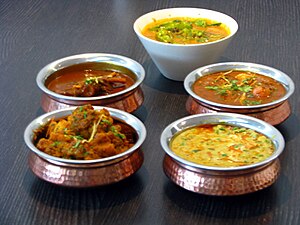 インドカレー | |
| Place of origin | Indian subcontinent |
|---|---|
| Region or state | Worldwide |
| Main ingredients | 肉あるいは、野菜, オイルあるいは、ghee/ja, スパイス |
カレー(Curry)は、主に南アジア料理に関連する、スパイスで味付けされたソースまたは肉汁を使った料理である。カレーはカレーの木の葉とは混同されないが、カレーの葉を含むカレーもある。カレーは多くの東南アジアおよび東アジア諸国の郷土料理で調理される。
カレーには多くの種類がある。伝統的な料理のスパイスの選択は、その地域の文化的伝統や個人の嗜好に左右される。そのような料理には、材料、スパイス、調理法を示す名前がついている。インド亜大陸以外では、カレーは東南アジアの料理で、ココナッツミルクやスパイスペーストを使い、ご飯にかけて食べるのが一般的である。カレーは魚、肉、鶏肉、貝類を単独で、または野菜と組み合わせて使う。ベジタリアンのものもある。マサラミックスとは、いくつかのカレーによく使われる自家製の乾燥スパイスや乾煎りスパイスの組み合わせのことである。
ドライカレーは少量の液体を使用して調理され、蒸発させることで他の材料はスパイスミックスでコーティングされた状態になる。ウェットカレーは、ブロス、ココナッツクリームまたはココナッツミルク、乳製品のクリームまたはヨーグルト、または豆のピューレ、ソテーした砕いたタマネギ、またはトマトピューレーをベースにしたソースまたはグレービーソースをかなりの量含む。西洋で市販されているカレー粉は、18世紀にインドの商人がガラムマサラに似たスパイスを調合したものをイギリスに帰国したイギリス東インド会社に売ったのがイギリスへの最初の輸出である。
語源
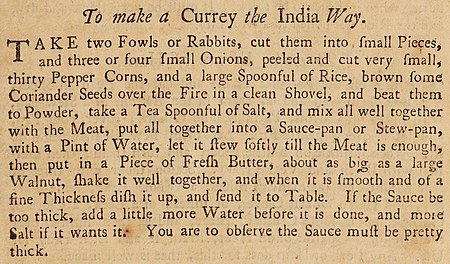
カレーは、カレーノキ(Murraya koenigii)の葉を使った「ソース」や「ご飯のおかず」を意味するタミル語のka↪L_1E5F↩i(க)の英語化形である。また、kariは他のドラヴィダ語、すなわちマラヤーラム語、カンナダ語、コダヴァでも「あらゆる種類の野菜(または肉)(生または茹でたもの)、カレー」の意味で使われる。Kaṟは、17世紀半ばにインド南東部のコロマンデル海岸沿いのタミル商人と交易していたイギリス東インド会社のメンバーによるポルトガル語の料理本に記載されており、「......カリ・ポディまたはカレー粉と呼ばれるスパイスのブレンド」として知られるようになった。英語化された形(スペルはcurrey)で最初に登場したのはHannah Glasseの1747年の著書The Art of Cookery Made Plain and Easyである。
1390年代のイギリスの料理本The Forme of Curyに登場するcurryという単語は無関係であり、「調理する」という意味の中世フランス語cuireに由来する。
歴史
東南アジアのオーストロネシア人の商人が南アジア(主にインドとスリランカの南東海岸の港)と東アジアを結ぶ海上交易路で香辛料を取引していた証拠が、紀元前5000年前にまでさかのぼる昔に発見されている。また、モヘンジョ・ダロから出土した紀元前2600年頃の考古学的証拠からは、マスタード、フェンネル、クミン、タマリンドの鞘を含む香辛料を搗くために乳鉢と乳棒が使用されていたことが示唆されており、これで料理に香りを付けていた。黒胡椒はインド亜大陸と東南アジア原産で、少なくとも紀元前2000年頃からインド料理で知られている。
スパイシーなシチューの基本的な材料は、ショウガ、ニンニク、ターメリックの3つだった。考古学者たちは「デンプン粒分析」と呼ばれる方法を用いて、インドで発掘された骸骨と陶器の破片の両方からこれらの香辛料の残留物を特定し、ターメリックとショウガが存在することを発見した。
16世紀初頭にムガル帝国が成立したことも、特に北部のカレーに影響を与えた。もうひとつの影響は、1510年にゴアにポルトガルの貿易センターが設立されたことで、コロンブス交易の副産物としてアメリカ大陸からインドに唐辛子、トマト、ジャガイモがもたらされた。
イギリスではソースを使った料理はすべて「カレー」という総称で括られていた。17世紀にアングロ・インド料理からイギリス料理に伝わり、平凡な茹で肉や煮肉にスパイシーなソースが加えられるようになった。カレーは1809年からイギリスのコーヒーハウスで提供されるようになり、1940年代と1970年代に大流行した。19世紀には、カレーはイギリスの砂糖産業で働くインド人年季奉公労働者によってカリブ海に運ばれた。20世紀半ば以降、多くの国のスタイルのカレーがその起源から遠く離れた場所で人気を博し、ますます国際的なフュージョン料理の一部となっている。
地域毎
南アジア


インドはカレーの本場であり、多くのインド料理はカレーベースで、さまざまな種類の野菜、レンズ豆、肉を加えて調理する。カレーの内容や調理法は地域によって異なる。ほとんどのカレーは水ベースで、乳製品やココナッツミルクを使うこともある。カレー料理は通常濃厚でスパイシーであり、蒸した米や様々なインドパンと一緒に食べる。例えば、カシミール料理で人気のあるローガン・ジョシュは、カシミール産の唐辛子とケイトウの赤い花のエキス(mawal)で色付けされた赤いグレービーソースを使った羊肉のウェットカレーである。ゴシュタバ(Goshtaba)(ヨーグルトのグレイビーソースで煮込んだ大きな羊肉のミートボール)は、西洋のレストランで時折見られるワズワン伝統のもう一つのカレー料理である。
ベンガル料理では、カレーはトルカリと呼ばれる。カレーには魚介類、野菜、肉類が含まれる。マスタードシードとマスタードオイルは多くのレシピに加えられ、多くの場合タルカの形で加えられる。ベンガルで人気のあるカレーには、Murgi'r Lal Jhol、Shorshe Illish、Kosha Mangsho、Chingri Malai、Rezalaなどがある。メズバンは、バングラデシュのベンガル系イスラム教徒がチッタゴン地区で開催する人気の社会的な祭り。
この祭りには、「メズバニ牛肉」を意味する「メズバニ・ゴシュト」と呼ばれる独特のビーフカレーが登場する。このカレーの調理は、巨大な「deghs」と薪、そして長年の経験と完璧な技術を必要とする、大規模かつ複雑な工程である。
米とカレーはスリランカの主食である。
東アジア
カレーはアジアの他の地域にも広がった。中国料理には欠かせないものではないが、中国の南部ではいくつかの料理にカレー粉が加えられている。中国の食料品店で売られているカレー粉はマドラスカレー粉に似ているが、スターアニスとシナモンが加えられている。ポルトガルの植民地であったマカオには独自の料理伝統があり、ガリーニャ・ア・ポルトゥゲーザやカレーカニなどのカレー料理がある。ポルトガルソースはカレー風味のソースで、ココナッツミルクでとろみをつけたものである。

日本のカレーは通常、カレーライス(karē raisu) として食べられている。- カレー、ライス、そしてしばしば漬け物が同じ皿に盛られ、スプーンですくって食べる、よくあるランチタイムの食堂料理である。インドや東南アジアのカレーに比べると辛さや味付けは控えめで、カレーというよりは濃厚な煮込み料理である。イギリス人がインド植民地からカレーをイギリスに持ち帰り、日本には鎖国政策が終わった明治時代(1868年~1912年)に伝わり、日本のカレーは西洋料理に分類されるようになった。カレーが全国に広まったのは、日本陸軍や海軍が、便利な野戦料理や海軍の水筒料理として大々的に採用し、僻地の徴兵にも体験させたことによる。海上自衛隊では、毎週金曜日の昼食にカレーを食べるのが伝統となっており、多くの艦艇が独自のレシピを持っている。標準的な日本のカレーは、玉ねぎ、にんじん、じゃがいも、時にはセロリ、そして大きな鍋で煮込んだ肉が入っている。甘みを増すためにすりおろしたリンゴや蜂蜜が加えられることもあり、代わりに他の野菜が使われることもある。
カレーが韓国料理に広まったのは、1969年にオットギがカレー粉で韓国食品業界に参入してからである。韓国のカレーは通常ライスと一緒に提供され、ターメリックの黄金色が特徴である。カレートッポッキはトック(餅)、オムク(魚の餅)、卵、野菜、カレーで作られる。カレーはポックムパプ(チャーハン)、スンドゥブチゲ(絹ごし豆腐のチゲ)、フライドチキン、野菜炒め、サラダなどの韓国料理に加えることができる。
東南アジア
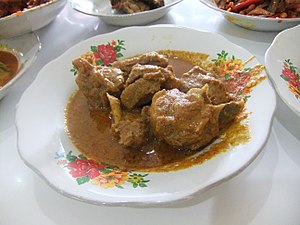
インド・インドネシア料理は、インドの本格的な料理をアレンジしたものと、インドネシアの多様な食文化にインスパイアされた創作料理からなる。インドネシア語のカレーはkariであり、ジャワ語のカレーはkareである。インドネシア料理、特にバンドンでは、ロントンと牛肉の黄色いカレースープを合わせたロントン・カリという料理がある。ジャワ料理では、東ジャワのトゥバン県でワタリガニのカレーであるkare rajunganが珍味となっている。ルンダンは|ミナンを起源とするインドネシアの国民食であり、従来のマレーシアのカレーよりも辛口で肉が多く、ココナッツミルクが多く含まれている。
マレーシア料理は、当初はインド系住民を介してカレーを取り入れたのかもしれないが、マレー系住民や中華系住民の間では主食となっている。マレーシアのカレーには通常、ターメリックが豊富なカレー粉、ココナッツミルク、エシャロット、ショウガ、ベラカン(エビのペースト)、唐辛子、ニンニクが使われる。タマリンドもよく使われる。

ビルマ料理では、カレーは広くヒンと呼ばれる。一般的にビルマカレーは、エシャロット、タマネギ、ショウガ、ニンニクなどの香辛料とターメリック、パプリカ、ガラムマサラなどの乾燥スパイスをベースにしたカレーで、タンパク質を煮込んだものである。ビルマのカレーは、他の東南アジアのカレーとは異なり、料理の味付けに乾燥スパイスもよく使われ、ココナッツミルクは一部の料理にのみ控えめに使われる。

フィリピンでは、2種類のカレーの伝統が、ヒスパニック化した北部とインド化/イスラム化した南部の文化的分裂に対応して見られる。北部では、直線的な新しいカレーレシピが見られる。最も一般的なのは、ginataang manok(ココナッツミルクで煮込んだ鶏肉)料理にカレー粉を加えたもので、「フィリピンチキンカレー」として知られている。これはフィリピン北部の人々がよく知る普通のカレー料理である。同様に、「カレー」とみなされる他のフィリピン北部料理は、ginataan(ココナッツミルクで調理したもの)adobo、kaldereta、mechadoなど、他の土着の肉料理や魚介料理にカレー粉やインド以外のスパイスを加えただけのものであることが多い。

タイ料理では、カレーはkaengと呼ばれ、通常、唐辛子、タマネギまたはエシャロット、ニンニク、エビペーストから作られたペーストをベースにしたソースに肉、魚、または野菜を入れたものである。追加のスパイスやハーブがカレーの種類を決める。唐辛子、カフィアライムの葉、レモングラス、ガランガルなどの地元の食材が使われ、中部と南部のタイ料理ではココナッツミルクが使われる。北部と北東部のタイカレーには一般的にココナッツミルクは使われない。砂糖とココナッツミルクを使うため、タイカレーはインドカレーよりも甘くなる傾向がある。西洋では、タイのカレーを色で表現することがある。レッドカレーは赤唐辛子を使い、グリーンカレーは青唐辛子を使う。イエローカレー-kaeng kariと呼ばれる。タイ語ではkaeng kariと呼ばれ、直訳すると「カレースープ」だが、ターメリックやクミンなどの乾燥スパイスを使い、インドカレーに近い。タイ料理の炒め物には、インド風のカレー粉(タイ語: phong kari)を使うものもいくつかある。

ベトナム料理ではcà riと呼ばれ、ココナッツミルク、ジャガイモ、サツマイモ、タロイモ、鶏肉などの材料にコリアンダーやネギを加えて作る。インドカレーというよりスープに近い。ヤギ肉のカレーもあるが、ベトナムでは一部の特別なレストランでしか食べられない。カレーにはパンや春雨、米が添えられることが多い。カレーは南部の料理と考えられている。カレーの他の材料は非常に多様で、肉の材料、カレーを調理するための主な果物、シェフの創造力によって異なります。ベトナムのカレーは、ココナッツミルク、レッドカシュー、玉ねぎ、生姜、ジャガイモ、サツマイモ、ニンジン、大根、野菜、様々な種類の肉でも作られる。
アフリカ
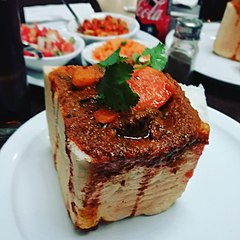
カレーの消費は、植民地時代にインド亜大陸からこの地域への人々の移住とともに南アフリカに広まった。アフリカンカレー、ケープマレーカレー、ナタールカレーには、伝統的なナタールカレー、ダーバンカレー、バニーチャウ、ロティロールなどがある。南アフリカのカレーはクワズールー・ナタール州と西ケープ州の両方で誕生したようであるが、他のカレーは20世紀後半から21世紀初頭にかけて全国的に発展し、エカシ・カレー、カラー・カレー、アフリカーナー・カレーなどがある。ダーバンはインド以外のインド人の人口が世界最大である。バニー・チャウまたは「セット」と呼ばれる南アフリカの定番料理は、ラム、チキン、豆のいずれかのカレーをトンネル状にくりぬいたパンに注いで、パンの切れ端を指につけて食べるものである。
ヨーロッパ

カレーはイギリスで非常に人気があり、ほぼすべての町にカレーハウスがある。イギリスでのカレーの人気は高く、「国民食」とも呼ばれている。2016年には12,000軒のカレーハウスがあり、10万人を雇用し、年間総売上高は約42億ポンドと推定されている。
提供される料理はイギリス人好みに調理されたインド料理だが、本格的なインド・スタイルへの需要が高まっている。2015年現在、カレーハウスは英国のレストラン事業の5分の1を占めているが、歴史的に低賃金部門であるため、労働力不足に悩まされていた。南アジアからの定着したインド系移民は他の職業に移っており、ヨーロッパ人にカレーを調理させるのは困難で、熟練した移民には高い賃金を支払う必要がある移民規制が、新しいコックの供給を圧迫していた。
カレー粉
欧米の一部の市場で販売されている "カレー粉"は、市販のブレンドスパイスであり、インドの商人がヨーロッパの植民地商人に販売したのが始まりである。18世紀後半から市販され、Crosse & BlackwellやSharwood'sなどのブランドが現在まで続いている。イギリスの貿易商は19世紀半ばにこの粉を明治の日本に紹介し、ジャパニーズカレーとして知られるようになった。
こちらも参照
ギャラリー
-
バルティラムカレー
-
インド料理店で出されるバターチキン
-
ケララのバターミルクカレー
-
パキスタンのカレーチキン
-
ホームメイドチキンティッカマサラ
-
Karnataka food
-
Korean curry rice
-
ケララのマンゴーカレー
-
ニハリサラダに添えられるニハリ
-
ゴアレストランでのポークビンダルー
-
タイのレッドローストダックカリー (ホットアンドスパイシー)
-
ライスとチェノポディウム・アルバム'の葉のカレー、玉ねぎとジャガイモ入り;ベジタリアン・カレー
-
ローガンジョシュカレー
-
ヨーグルトとグラム粉カレー
-
アンダ(卵)カレー
こちらも参照
さらに読む
- Chapman, Pat. Curry Club Indian Restaurant Cookbook. London – Piatkus.ISBN 0-86188-378-0 & ISBN 0-86188-488-4 (1984 to 2009)
- Chapman, Pat. The Little Curry Book. London – Piatkus.ISBN 978-0861883646 (1985)
- Achaya, K.T. A Historical Dictionary of Indian Food. Delhi, Oxford University Press (1998)
- Grove, Peter & Colleen. The Flavours of History. London, Godiva Books (2011)
- Chapman, Pat. India: Food & Cooking. London, New Holland – ISBN 978-1-84537-619-2 (2007)
- Indian Food: A Historical Companion. Delhi, Oxford University Press, 1994
- David Burton. The Raj at Table. London, Faber and Faber (1993)
- Pat Chapman's Curry Bible. Hodder & St – ISBN 0-340-68037-7 & ISBN 0-340-68037-7 & ISBN 0-340-68562-X & ISBN 0-340-68562-X (1997)
- New Curry Bible, An unaltered edition of Pat Chapman's Curry Bible published by John Blake Publishers. ISBN 978-1-84358-159-8 (2005)
- E.M. Collingham. Curry: A Biography. London, Chatto & Windus, 2005
- An Invitation to Indian Cooking. London, Penguin, 1975
- Jaffrey, Madhur. Various books on curry from 1973 to 2015.
- Chapman, Pat. Petit Plats Curry. Paris. Hachette Marabout. ISBN 2-501-03308-6 (2000)
- Curry
- Afghan cuisine
- Belizean cuisine
- Bengali cuisine
- Bangladeshi cuisine
- Bhutanese cuisine
- British cuisine
- Burmese cuisine
- Chili pepper dishes
- Chinese cuisine
- Fijian cuisine
- Guyanese cuisine
- Indian cuisine
- Indo-Caribbean cuisine
- Indonesian cuisine
- Jamaican cuisine
- Japanese cuisine
- Kashmiri cuisine
- Korean cuisine
- Malaysian cuisine
- Maldivian cuisine
- Mauritian cuisine
- Nepalese cuisine
- Omani cuisine
- Pakistani cuisine
- Filipino cuisine
- Saint Helenian cuisine
- Seychellois cuisine
- Somali cuisine
- South African cuisine
- South Asian cuisine
- Sri Lankan cuisine
- Thai cuisine
- Vietnamese cuisine

